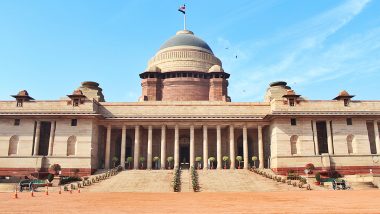Mumbai, June 9: President Ram Nath Kovind’s five-year term ends on July 25. He was elected as the 14th President of India on 25 July 2017. A member of the BJP, President Kovind is also the first person from Uttar Pradesh to serve as President of India. President Kovind's tenure was one of the most influential as he visited 29 countries till December 2021 and enhanced India’s global outreach and footprint. He also received the highest State honours from six countries - Madagascar, Equatorial Guinea, Eswatini, Croatia, Bolivia, and the Republic of Guinea as President of India.
As President Kovind's tenure ends on July 24, according to Article 62 of the Constitution, an election for the 15th President of India must be held before the incumbent's term ends. Presidential Election 2022: Election Commission to Announce the Schedule for Polls for the Next President of India Today.
The Election Commission (EC) announced the schedule for the presidential election on Thursday at 3 PM. The election to choose the next President of India will be held on July 18 and the results will be announced on July 21.
Here Is How President Of India Is Elected
Nomination:
Candidates who wish to run for the President of India's office are supposed to file their nominations and they also have to submit over Rs 15,000 as a deposit, and a signed list of 50 proposers and 50 seconders. The proposers and seconders can be any of the 4,809 electors eligible to vote in the Presidential election 2022.
Election:
The Election Commission of India overlooks the Presidential Election as the rules made under Article 324 of the Constitution, the Presidential and Vice-Presidential Elections Act, 1952. The President of India is elected by the Members of an Electoral College consisting of the elected members of both Houses of Parliament and the elected members of the Legislative Assemblies of the States including the UTs and NCTs of Delhi and Puducherry. The electoral college consists of 233 members of the Rajya Sabha, 543 members of the Lok Sabha, and 4,033 members of legislative assemblies giving a total of 4,809 electors.
However, the members of the state assemblies and the two Houses who were nominated by the President himself are not allowed to participate in the presidential election.
Voting:
As per the ECI, the election shall be held with the system of proportional representation by means of a single transferable vote and the voting shall be by secret ballot. The total votes for the President of India election are counted on the basis of their value, which varies from State to State. The candidate has to get at least 50 percent plus one vote to be declared elected.
The total number of votes that a Presidential candidate secures is calculated by adding up the value of all the ballots in which a particular candidate receives a first preference. The candidate who garners more votes than the quota is declared elected as President of India by the Returning Officer.
Oath Taking:
The President-elect takes the oath a day after the serving President exits the office. The oath of the President is administered by the Chief Justice of India.
The presidential elections in 2017 were held on July 17, while the declaration of the winner — Ram Nath Kovind — was made three days later on July 20.
(The above story first appeared on LatestLY on Jun 09, 2022 03:23 PM IST. For more news and updates on politics, world, sports, entertainment and lifestyle, log on to our website latestly.com).













 Quickly
Quickly





















